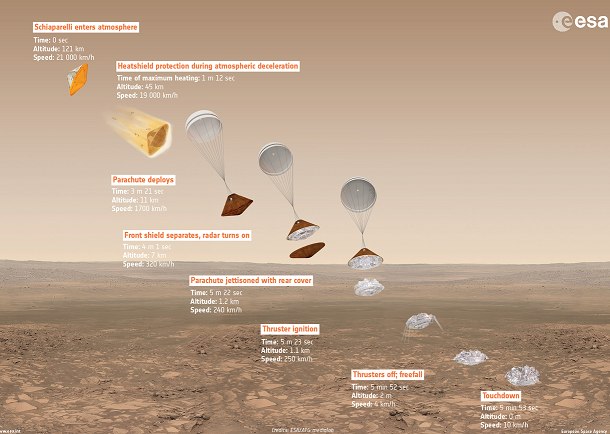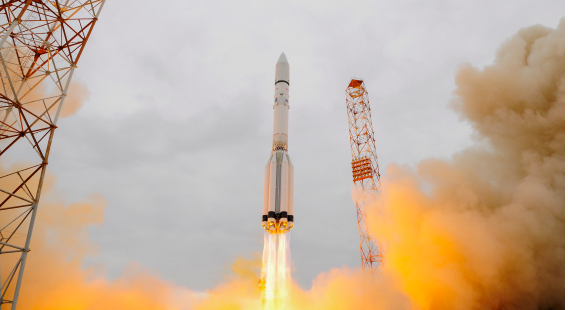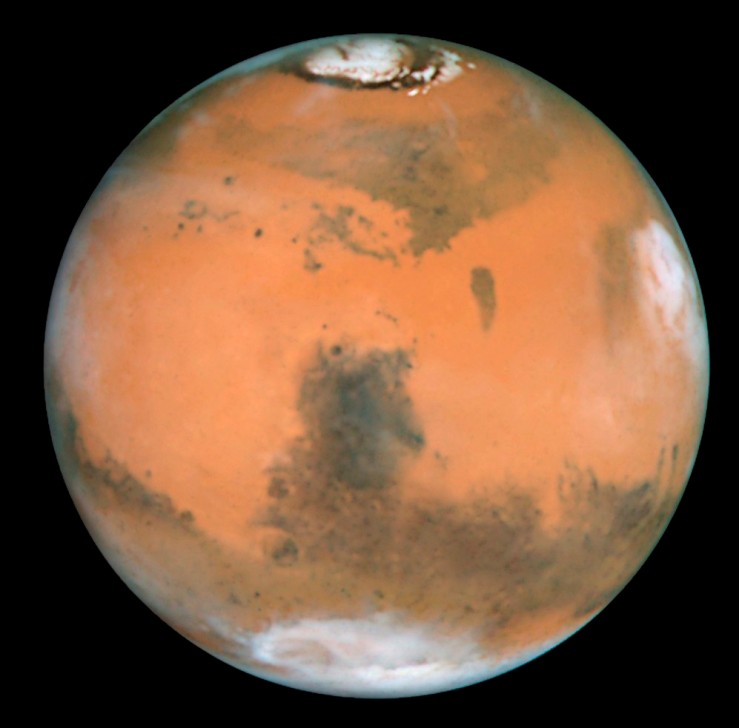As most of you will already know, and much to our disappointment, the Schiaparelli probe failed to land successfully on Mars last Wednesday. The plan was that when it entered the Martian atmosphere, the spacecraft would immediately begin to slow down to 1700 km/h as a result of the friction caused by the atmosphere hitting its heat-shield. When it reached this speed, and was 11 km above the Martian surface, a parachute would open for two minutes to slow it down to 240 km/h. The parachute would then be jettisoned to get it out of the way, allowing thrusters to fire like the brakes on an aeroplane. The spacecraft would then touch down on the planet’s surface at a gentle 10 km/h.
Image from ESA
Unfortunately, what appears to have happened is that the parachute only opened for a few seconds and so failed to slow the spacecraft down. The spacecraft will have crashed into the surface at thousands of km/h and will have been destroyed by the impact. It is very disappointing for the European Space Agency(ESA), especially since their only previous attempt to land on Mars (Beagle 2) back in 2003 ended in failure. However It’s not all bad news as Schiaparelli had only a small suite of instruments and was only designed to last for about a week on the Martian surface. The main spacecraft of the mission, the ExoMars Trace Gas Orbitor (TGO), is now successfully in orbit around the planet, and is set to study the way methane is distributed in the Martian atmosphere.
—Original post below
On 14 March 2016 ESA used facilities at Baikonur in Kazakhstan to launch their long awaited mission to Mars, the not so snappily named ExoMars Trace Gas Orbiter (TGO) and, bolted onto it, a smaller probe called Schiaparelli. Although the much larger TGO will only orbit Mars, next Wednesday, 19 October, Schiaparelli will attempt to land on the surface of of the planet, after its seven month journey.
Assuming all goes well, the spacecraft will land on a flat area called Meridiani Planum, close to the equator. Currently this region on Mars is in its dust storm season. Dust storms occur often on Mars and can be very large, covering an area the size of the US, and may last for many weeks. During a dust storm the dust is so thick that it is not possible to see the Martian surface from Earth or even a spacecraft orbiting the planet. It also blocks much of the sunlight from reaching the planet’s surface. This was an important part of the storyline in “The Martian” where the hero’s car batteries were unable to move due to the lack of solar power, nearly stranding him.
Schiaparelli carries a collection of instruments called DREAMS (Dust characterisation, Risk assessment, and Environment Analyser on the Martian Surface), to study the Martian environment.
The DREAMS instruments will be able to measure the local wind speed and direction, humidity, pressure, atmospheric temperature, the transparency (or how the amount of light which which gets through the atmosphere varies) and atmospheric electric fields which may be caused by dust. Unlike nearly all other spacecraft, Schiaparelli will have a non- rechargeable battery. The battery will only last for about a week, after which the spacecraft will run out of power and stop functioning. The decision to go for non chargeable battery was made because Schiaparelli is a relatively simple lander, with a small set of instruments and will have completed its mission within the week in which it will be operational. The main part of the mission, however, is a spacecraft which will orbit Mars for at least 6 years, and this is the TGO.
The aim of the TGO is to study how the distribution of the gas methane varies according to its position on the planet’s surface and over the course of time.
Image from ESA
What is the significance of methane on Mars?
Compared to the Earth, Mars has a very thin atmosphere. Its surface pressure is only 0.6% of that of the Earth. The atmosphere mainly consists of carbon dioxide. However, it also contains a small amount of methane (around 0.000001%) (ESA 2004). This is a puzzle to scientists because the ultraviolet light from the Sun should break up any methane within 600 years, and Mars is 4.5 billions old. Therefore there must be some process occurring on Mars which is constantly replenishing the methane.
Mars- Image from NASA
There are various possibilities for the origin of this methane. One is that it is released by geological processes such as volcanoes or a chemical process occurring within rocks called serpentinisation. This is not as exciting as it sounds (no snakes, I’m afraid) – it is simply a slow chemical reaction between olivine (a mineral found on Mars) carbon dioxide and water which can produce methane. Another is that there is a large reservoir of methane locked away in the ice below the Martian surface and as the temperature varies some of the ice may melt, thus releasing the methane into the atmosphere.
A fascinating possibility is that the methane is created by microorganisms below the planet’s surface. On Earth more than 90% of methane in the atmosphere is produced by living organisms (ESA 2014). There are over 50 species of microorganisms known as methanogens that live off organic matter and produce methane as a waste product. These microorganisms are found not only in wetlands (producing what is known as marsh gas) and in the soil but also in the guts of many animals such as cows and humans. At the risk of sounding somewhat vulgar, the methane gas escapes from both cattle and ourselves in the form of flatulence.
Methanogens
What will the TGO measure?
The TGO will measure how the methane content of Mars’s atmosphere varies with space and time. It will also be able to measure the concentration of other gases such as sulphur dioxide (which on Earth is normally associated with volcanic activity) and organic compounds such as ethane, methanol and formaldehyde (which on Earth are produced by living organisms). Although the TGO won’t be able to say for definite what the sources of the methane found on Mars are, if the concentration of methane were found to vary with the seasons and also if methane were found in conjunction with other organic chemicals it would point towards a biological origin.
How long with the mission be?
The TGO is a joint mission between the European Space Agency (ESA) and the Russian Space Agency (Roscosmos). The mission is described in more detail on ESA (2016). Now it has arrived at Mars it will spend a year gradually adjusting its orbit and by December 2017 it will be in a low circular orbit only 400 km above the Martian surface where it will spend the next 5 years mapping the methane distribution.
References
ESA (2004) Mars Express Confirms Methane in the Martian Atmosphere, Available at:http://www.esa.int/Our_Activities/Space_Science/Mars_Express/Mars_Express_confirms_methane_in_the_Martian_atmosphere(Accessed: 20 March 2016).
ESA (2014) The enigma of methane on Mars, Available at:http://exploration.esa.int/mars/46038-methane-on-mars/ (Accessed: 20 March 2016).
ESA (2016) Robotic exploration of Mars, Available at:http://exploration.esa.int/mars/46124-mission-overview/ (Accessed: 20 March 2016)





[…] is currently planning to send humans to low-Mars orbit in the early 2030s (remember the probe that crashed there 1 year ago?). Here you can read more about journey to Mars […]
LikeLike
[…] (Source: The Science Geek, Schiaparelli on Mars -updated) […]
LikeLike
Oh, this is a disappointment! I was hoping we’d get some exciting news to distract us from this horrible election mess going on right now. Plus I was having so many nice daydreams about either going to Mars to escape Donald Trump or sending Trump there himself.
LikeLike
Very true.
When I saw the news of what had happened I felt really sorry for the all the scientists, engineers and technicians on the project who had invested so much time and effort on it.
The Science Geek
LikeLike
Mars – You wanna come here, you gotta work for it. 🙂
LikeLike
Very true !!
LikeLiked by 1 person
So disappointing, but let’s look on the positive side. We’ll get so much from the orbiter.
LikeLike
Very True !!!
LikeLike
Reblogged this on The Somnium Project.
LikeLiked by 1 person
Great article!
LikeLiked by 1 person
Thank you
LikeLike
I hadn’t caught up with the news for a couple of days but figured something had gone badly wrong. ESA seems not to have much luck getting a soft landing on Mars – the Beagle, now Schiaparelli – though it’s an extremely tricky thing to do at the best of times. But there’ll be some good science from the orbiter, which is the primary mission.
LikeLiked by 1 person
Yes, very true. Landing n Mars was always going to be tricky and to date roughly 50 per cent of previous attempts have failed. The major part of the mission is the orbiter, which hopefully will produce some interesting results. Were it to confirm that the methane is likely to be organic in origin that would be an amazing result.
LikeLiked by 1 person
Landing on Mars is very difficult to execute safely. I thought you would appreciate seeing this imagery and story from the Mars orbiter.
http://www.nasa.gov/feature/jpl/camera-on-mars-orbiter-shows-signs-of-latest-mars-lander
LikeLiked by 1 person
Thank you
LikeLike
Thanks for the update and explaining what happened!
LikeLiked by 1 person
[…] via Schiaparelli on Mars -updated — The Science Geek […]
LikeLike